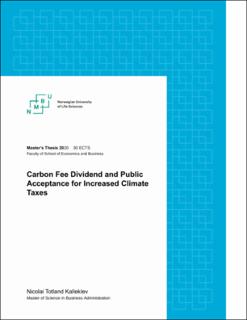| dc.description.abstract | The failure of undervalue or unpriced externalities, such as emissions, have led us to an unsustainable path that threatens our environment, our overall welfare and economic growth.
To make the transaction to a “green economy” as efficient as possible, could policymakers through the usage of policy instruments, increase prices on fossil fuels. However, previous attempts and studies show that there is a general public resistance over increasing prices on fossil fuels to a level that is coherent with the social cost. A key issue for policymakers is therefore to gain public acceptance over increased prices on polluting products. Environmental economists have for decades tried to create the “perfect” policy design that yields most benefits, to further gain public acceptance. However, as complexity of these policies have increased, more oppositional arguments and alternatives have emerged. This has made the process of implementing environmental policies a complex, and costly matter.
The studies by Aasen et al (2019) outlines that the vast majority of the Norwegian population see climate change as a comprehensive issue, however that they do not want their own economy being affected by the “green shift”.
The aim for this thesis is thus to present a proposal on how Norway could gain public acceptance over the implementation of a more ambitious green tax reform in the context of reaching their climate goals by 2030. Implementing a policy design where all the revenue is distributed back to the public, such as the “Carbon Fee Dividend” design, will eliminate many of these hurdles that have been correlative with the present tax system. Goulder (1995) argues that a revenue-neutral policy almost always will achieve the environmental objective, as well as being highly costsaving. The simplicity of the design, and the perceived ease to mobilize for such a tax scheme, indicate a rapid implementation process. Given scientists' increased concern over current insufficient emission reductions, suggest the need for fast implementation of effective policies. | en_US |

